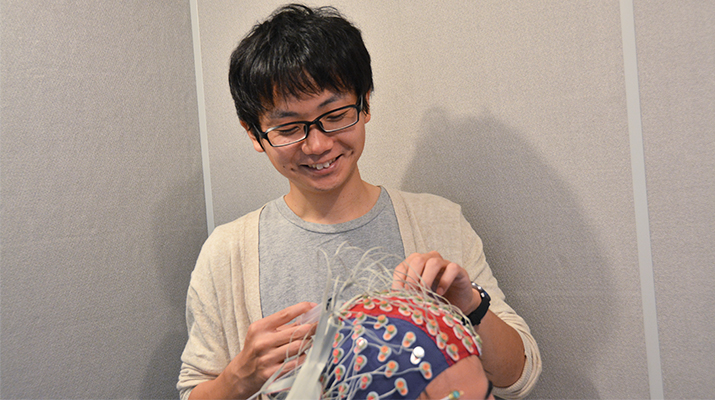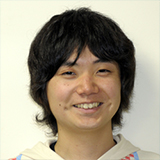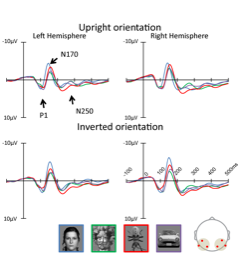
ここからコンテンツです。

Do We Subconsciously Judge Face-likeness?
Keys to uncovering the face-likeness recognition mechanism using brain waves By Yuji Nihei
Yuji Nihiei, a Ph.D student, and a member of the research team of the Visual Perception and Cognition Laboratory at the Toyohashi University of Technology has suggested that face-likeness is judged by early visual processing at around 100ms after viewing an object. The present study focused on the relation between face-likeness recognition and brain activity to suggest for the first time that face-likeness recognition is influenced by early visual processing.
The results of the present study were published in Frontiers in Human Neuroscience.
Face-likeness recognition is the act of recognizing a non-face object as a human face. This phenomenon is called "pareidolia," and refers to "perceiving an inherently meaningless object such as a pattern, landscape or object as another object with meaning." Many spirit photographs rely on this phenomenon. While pareidolia has been argued to occur in relatively low-level visual processing, at what level of visual processing pareidolia actually occurs was never previously discerned.
Therefore, the research team of the Visual Perception and Cognition Laboratory at the Toyohashi University of Technology decided to study the relation between behavior when a face-like object is viewed and brain activity to reveal the level of visual processing at which face-likeness is recognized.
PhD student and lead author of the study Yuji Nihei explains that, "Visual processing of the human face is divided into three different stages. The first stage is early visual processing of roughly identifying the object. Then, if the object is a face, distinguishing the parts of the face (eyes, nose, mouth) from one another and processing the outline and parts of the face. Lastly, expression and individual differences are distinguished. We studied the relation between activity at these three stages of processing and the results of actual recognition and determined that face-likeness recognition occurs in the first stage of visual processing. This processing occurs at a speed of approximately 100ms after viewing an object, and so we believe that face-likeness processing occurs before we are aware of the object."
Associate Professor Minami Testuto, who leads the research team, says that, "While seeing face-likeness in various objects could be considered incorrect in terms of object recognition, we believe this is not just a mistake and actually makes us reconsider an important cognitive function. We would like to continue our study of face-likeness recognition from an objective approach."
The results of this study are believed to serve as a key to uncovering the mechanism of how humans recognize and distinguish between two types of information - "face-likeness" and objects. The results of the present study also suggest that "face-likeness" recognition occurs in early visual processing and that face-like objects are processed in the same manner as a human face in later stages. Due to this, we believe that face-likeness can be caused by an effect that gathers attention to the face, or some other like stimulus.
The present study was conducted with the assistance of Grants-in-Aid for Scientific Research numbers A(26240043) and C(25330169) from the Japan Society for the Promotion of Science. The lead writer Yuji Nihei also received a grant as part of the Program for Leading Graduate Schools (R03) run by the Japan Society for the Promotion of Science.
Reference
Nihei, Y., Minami, T., Nakauchi, S., Brain Activity Related to the Judgment of Face-Likeness: Correlation between EEG and Face-Like Evaluation, Frontiers in Human Neuroscience,
https://doi.org/10.3389/fnhum.2018.00056
我々は無意識に顔らしさを判断している?
脳波を用いた顔らしさ認知メカニズム解明へのてがかりBy 二瓶 裕司
豊橋技術科学大学情報・知能工学系視覚認知情報学研究室の研究チームは、顔らしさの判断が物体を見てから約100msという早期の視覚処理で行われることを示唆しました。本研究では、顔らしさの認知と脳活動の関連に着目し、世界で初めて顔らしさ認知が早期の視覚処理の影響を受けていることを示しました。本研究成果はオープンアクセス誌frontiers in Human Neuroscienceに掲載されました。
顔らしさ認知とは、ヒトの顔ではない物体に対してヒトの顔のように認知してしまうことです。この現象は、パレイドリア現象と呼ばれ、「無意味な模様、風景、物体などが、別の意味のある何かにみえる」というものです。心霊写真の多くもこの現象とされています。この現象は、比較低次な視覚処理で生じていることは議論されていましたが、実際にどの視覚処理の段階で生じているかは明らかにされていませんでした。
そこで、豊橋技術科学大学情報・知能工学系視覚認知情報学研究室の研究チームは、顔らしい物体を見たときの行動と脳活動の関連を調査し、顔らしさ認知がどの視覚処理段階で生じるかを明らかにしました。
「ヒトの顔の視覚処理は3段階に分かれており、初めに物体の識別をおおまかに行う初期の視覚処理が行われ、顔であった場合にその顔のパーツ(目や鼻、口)の処理と輪郭とパーツの配置の処理が行われます。その後に、表情や個人の識別が行われます。我々は、この3段階の処理時の活動と実際の認知の結果の関連を調査し、顔らしさの認知が視覚処理の初期段階で既に行われていることを明らかにしました。この処理は物体を見てから約100msという早さで行われ、我々が物体を意識する前より既に顔らしさの処理が行われていることが考えられます。」と筆頭著者である博士後期課程の二瓶裕司は説明します。
研究チームのリーダーである南哲人准教授は「さまざまな物体に顔らしさを感じるというのは、物体認知としてはミスと言えますが、単なるミスではなくて重要な認知機能の裏返しではないかと考えています。今後も、顔らしさ認知について、多角的なアプローチで迫っていきたいと考えています。」
この研究の成果は「顔らしさ」という顔の情報と、物体という情報の2つの情報を持つ状態をどのようにヒトが認知し、切り分けるのかというメカニズムの解明の手がかりとなったと考えられます。また、今回の研究成果により「顔らしさ」は早期の視覚処理で行われ、その後ヒトの顔と同様に処理されていることが示されました。このことから、顔が持つ注意を集める効果等が「顔らしさ」によっても生じると考えられます。
本研究は、文部科学省・日本学術振興会科学研究費基盤研究A(26240043)、基盤研究C(25330169)の助成によって実施されたものです。また、筆頭著者の二瓶は文部科学省・日本学術振興会の実施する博士課程教育リーディングプログラム(R03)の支援を受けました。
Researcher Profile

| Name | Yuji Nihei |
|---|---|
| Affiliation | Department of Computer Science and Engineering |
| Title | PhD student |
| Fields of Research | Vision Science, Cognitive Neuroscience |
ここでコンテンツ終わりです。

